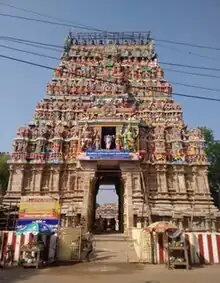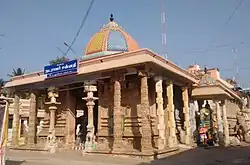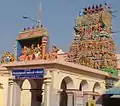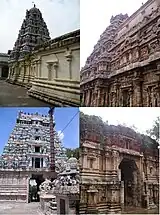Nageswaraswamy Temple
Nageswaraswamy Temple is a Hindu temple dedicated to Shiva located in Kumbakonam in Thanjavur district, Tamil Nadu, India. The presiding deity is revered in the 7th-century Tamil Saiva canonical work, the Tevaram, written by Tamil poet saints known as the nayanars and classified as Paadal Petra Sthalam. The temple is counted as the earliest of all Chola temples. Shiva in the guise of Nagaraja, the serpent king..
| Nageswaraswamy Temple | |
|---|---|
Kudanthai Keezhakottam | |
 | |
| Religion | |
| Affiliation | Hinduism |
| District | Thanjavur |
| Deity | Nageswaran(Shiva) |
| Features |
|
| Location | |
| Location | Kumbakonam |
| State | Tamil Nadu |
| Country | India |
 Location in Tamil Nadu | |
| Geographic coordinates | 10°57′31.4910″N 79°22′43.173″E |
| Architecture | |
| Type | Dravidian architecture |
| Creator | Cholas |
There are many inscriptions associated with the temple indicating contributions from Cholas, Thanjavur Nayaks and Thanjavur Maratha kingdom. The oldest parts of the present masonry structure were built during the Chola dynasty in the 9th century, while later expansions, including the towering gopuram gatehouses, are attributed to later periods, up to the Thanjavur Nayaks during the 16th century.
The temple complex is one of the largest in the state and it houses three gateway towers known as gopurams. The temple has numerous shrines, with those of Nageswarar, Pralayamkathanathar and Periyanayagi being the most prominent. The temple complex houses many halls and three precincts; the most notable is the second precinct built during the Vijayanagar period that has many sculptures. The temple has six daily rituals at various times from 5:30 a.m. to 10 p.m., and twelve yearly festivals on its calendar. The temple is maintained and administered by Hindu Religious and Charitable Endowments Department of the Government of Tamil Nadu.
Legend
During the time when Adisesha was feeling under the weight of the earth, he did penance at Kuvivanam. Parvathy appeared and blessed him at this place to get strength. The water body in the temple is called Naga Theertham.[1] The temple known is for its shrine of Rahu, one of the nine celestial bodies in the Navagrahas. A legend has it that the mythological serpents Dakshan and Kaarkotakan worshipped Lord Shiva here. Legend also has it that King Nala worshipped Shiva here as in Thirunallar. There is a Naganathar temple at Tirunageswaram having similar features like temple. This place has been referred in Tevaram written by Saint Tamil poet of 7th Century AD, Thirugnana Sambanthar.[2]
History
Aditya Chola constructed this temple during the 9th century. It is great marvel of Chola architecture, building technology and astronomy. The orientation is structured in such a way that it allows sunlight inside the temple, right on the sanctum only during the Tamil month of Chithirai (April/May). It bears another name called Surya Kottam or Keezha Kottam. The Karuvarai (Sanctum Sanctorum) of Nageswaran temple is similar to Sarangapani Temple, as it is made in the form of a Chariot. The temple consists of three gopurams in the eastern, western and southern directions. The temple is designed in such a way that during the first three days of Tamil month Chittirai (April - May), the rays of the Sun falls directly in the base of the presiding deity in sanctum sanctorum.[3]
The temple had been a centre of learning as seen from the inscriptions in the temple. The inscriptions indicate specific subjects like Purvamimansa styled as Pravahakarma. There were also provisions made for feeding and maintaining for teachers and students.[4] In modern times, the temple is maintained and administered by the Hindu Religious and Charitable Endowments Department of the Government of Tamil Nadu.[5]
Architecture
The temple is one of the prominent Shiva temples in Kumbakonam.[6] The temple shows early Chola art in its best form particularly in the form of human figures. The sanctum is of padabandha-padmaka type stands on padmopana. The lotus leaves of the padmopano are carved with vitality. In its iconographic scheme the Ardhanari, Brahma and Dakshinamoorthy in the niches of the outer wall are featured. The other sculptures on the walls almost life-size reflect either the donors to the temples or contemporary princesses and princes.[7] The epic scenes are in low relief on the plinth below the pilasters of the walls of the sanctum, recalling the wood work.[7]
The Devi shrine is an independent structure situated in the outer prakaram(outer precincts of a temple), detached from the axial unit, though it faces south, a feature common to Saiva Devin shrines. The complex of Nataraja shrine is in the form of a chariot on wheel drawn by horses as in the case of Airavatesvara Temple at Darasuram and Sarangapani Temple in Kumbakonam.[8] Similar architecture of halls (Mandapas) simulating a chariot drawn by elephant or horses is found in Sarangapani temple at Kumbakonam, Mela Kadambur Amirthakadeswarar Temple, Sikharagiriswara Temple, Kudumiyamalai, Vriddhagiriswarar Temple, Vriddhachalam and Thyagaraja Temple, Tiruvarur.[9]
According to historian Harle, the temple is counted among the four early extant temples of the Chola Empire, with the other three being Koranganatha Temple in Tiruchirappalli district, Moovar Koil in Pudukottai district, and Brahmapureeswarar temple in Thanjavur district. These temples follow the Pallava architecture which are relatively small in size. They all have a fair-sized porch, locally called ardhamandapa attached to the sanctum, both of which are slightly below the ground level in a pit kind of structure. The structures are also predominantly built of stone.[10]
During Rajendra Chola's Ganges expedition, the victorious chola army brought a beautiful Vinayagar statue as a war trophy to the chola empire. The Vinayagar statue was kept at this temple and was aptly named as Gangai Vinayagar. Currently, the Vinayagar is present in the ardha mandapam, in front of the sanctum of Nageswarar. The Vinayagar seems to be in the Pala style.
Festivals and religious importance

The temple priests perform the puja (rituals) during festivals and on a daily basis. Like other Shiva temples of Tamil Nadu, the priests belong to the Shaiva community, a Brahmin sub-caste. The temple rituals are performed five times a day; Ushathkalam at 6:30 a.m., Kalasanthi at 8:00 a.m., Uchikalam at 12:00 a.m., Sayarakshai at 5:00 p.m., and Ardha Jamam at 8:00 p.m. Each ritual comprises four steps: abhisheka (sacred bath), alangaram (decoration), naivethanam (food offering) and deepa aradanai (waving of lamps) for both Nageswarar and Periyanayagi. The worship is held amidst music with nagaswaram (pipe instrument) and tavil (percussion instrument), religious instructions in the Vedas (sacred texts) read by priests and prostration by worshipers in front of the temple mast. There are weekly rituals like somavaram (Monday) and sukravaram (Friday), fortnightly rituals like pradosham and monthly festivals like amavasai (new moon day), kiruthigai, pournami (full moon day) and sathurthi. Mahashivaratri during February - March is the major festivals celebrated in the temple. The major festival of the temple is the Brahmotsavam temple during Tamil month of Panguni when the Sun's rays fall directly on the image in the sanctum.[11]
Religious importance
Tirugnana Sambandar, a 7th-century Tamil Saivite poet, venerated Nageswarar in ten padigams in Tevaram, compiled as the First Tirumurai and second Tirumuari. Appar, a contemporary of Sambandar, also venerated Nageswarar in 12 padigams in Tevaram, compiled in the Fourth, fifth and sixth Tirumurai. Sundarar, the 8th century Nayanmar revered Nageswarar in seven padigams, which is compiled in Seventh Tirumuari.[12] As the temple is revered in Tevaram, it is classified as Paadal Petra Sthalam, one of the 275 temples that find mention in the Saiva canon. The temple is counted as the 52nd in the list of temples in the northern banks of Cauvery.[13] The temple is counted as one of the temples built on the banks of River Kaveri.[14] The Sun rays falling on the image of Shiva is considered as the worship of Surya.[15]
As per a Hindu belief, people troubled by Sarpa-dosha or Malefic effects Rahu-Kethu seek a relief by offering prayers in a single day to Kudanthai or Kumbakonam Nageshwarar in the morning, Thirunageshwaram Naganathar at the noon, Thirupamburam Pambureswarar in the evening and Nagoor Nageshwarar or Naganathar temple at night.[16]
Specialty
12 Shiva temples are connected with Mahamaham festival which happens once in 12 years in Kumbakonam. They are:
- Kasi Visanathar Temple,
- Adi Kumbeswarar Temple,
- Someswarar Temple,
- Nageswaraswamy Temple,
- Kalahasteeswarar Temple,
- Gowthameswarar Temple,
- Kodeeswarar Temple,
- Amirthakadeswarar Temple,
- Banapuriswarar Temple,
- Abimukeswarar Temple,
- Kambatta Viswanathar Temple and
- Ekambareswarar Temple.
This temple is one among them.[17]
Gallery
Notes
- V., Meena (1974). Temples in South India (1st ed.). Kanniyakumari: Harikumar Arts. p. 25.
- "campantar tEvAram -2" (PDF). projectmadurai.org. Retrieved 16 July 2011.
- R. 2001, pp. 217-8
- Tyagi, Anil Kumar (2013). "Educational Institutions (B.C. 200- A.D. 700)". In Iyer, Shymala M. (ed.). Ancient India. New Delhi: Publications Division, Ministry of Information and Broadcasting, Government of India. pp. 140–144. ISBN 978-81-230-1896-6.
- "Thirukoil - Temple list of Tamil Nadu" (PDF). Hindu Religious & Charitable Endowments Department, Government of Tamil Nadu. p. 216.
- Diwakar, Macherla (2011). Temples of South India (1st ed.). Chennai: Techno Book House. p. 138. ISBN 978-93-83440-34-4.
- R.K.K., Rajarajan (2008). "Identification of Portrait Sculptures of the Nāgēśvara Temple, Kuṃbhakōṉam". East and West (Rome). Rome: East and West. 58 (1–4): 405–414. ISSN 0012-8376. Retrieved 30 August 2020.
- Temples of South India P.112. V.V. Subba Reddy
- H., Sarkar (1974). The Kampahesvara temple at Thirubuvanam (PDF). Madras: Department of Archaeology, Government of Tamil Nadu. p. 9.
- Harle, James C. (1958). The Brahmapuriswara temple at Pullamangai (PDF). Bombay: Bhulabhai Memorial Institute. p. 9.
- "Sri Nageswarar temple". Dinamalar. 2019. Retrieved 25 April 2020.
- "Kudanthai Keezhakottam". Dharumapuram Adheenam. 25 April 2020.
- Swamigal, Tirunavukkarasu. "Tevaram Of Tirunavukkaracu Cuvamikal Tirumurai 5 part - 2 Poems(510-516)" (PDF). projectmadurai.org. pp. 33–34. Retrieved 13 December 2011.
- Ka. Vi., Kannan (2019). River cauvery the most battl(r)ed. Notion Press. p. 34. ISBN 9781684666041.
- Harshananda, Swami (2012). Hindu Pilgrim centres (2nd ed.). Bangalore, India: Ramakrishna Math. p. 78. ISBN 978-81-7907-053-6.
- Sharma, Sridhara (2007). Kumbakonam Azhaikkirathu. New Horizon Media. pp. 20–23. ISBN 9788183682244.
- Mahamaham Festival 2004 (in Tamil), Hindu Religious and Charitable Endowments Administration Department, Government of Tamil Nadu, 2004
References
- Ayyar, P. V. Jagadisa (1991). South Indian shrines: illustrated. New Delhi: Asian Educational Services. ISBN 81-206-0151-3..
- R., Dr. Vijayalakshmy (2001). An introduction to religion and Philosophy - Tévarám and Tivviyappirapantam (1st ed.). Chennai: International Institute of Tamil Studies.
.jpg.webp)
.jpg.webp)








